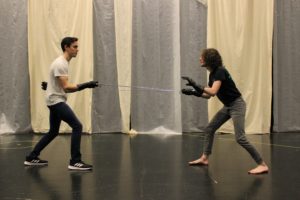
WCU School of Stage and Screen will be performing an adapted version of “Hamlet” on March 4-7.
William Shakespeare’s “Hamlet” has been performed for over 400 years, but never quite like this.
Western Carolina University’s School of Stage and Screen will be taking the stage to perform a revamped version of “Hamlet” from Wednesday, March 4, to Saturday, March 7, in the Bardo Arts Center Josephina Niggli Studio Theatre.
Performances on March 4 through the 6 start at 7:30 p.m., and the show on Saturday, March 7, will start at 3:30 p.m. Tickets start at $10 and can be purchased on online or at the box-office on the performance day.
The dean of the Belcher College of Fine and Performing Arts, George Brown, is adapting and directing this classic production to enhance the madness that the character Hamlet traditionally exudes.
“This adaptation is heavily infused with media, live camera work, sounds, and lighting. The idea behind this is to ask the question, ‘what if Hamlet was actually mad?’ The technology becomes a storytelling tool that allows us to explore that idea even further,” Brown said.
To show the variance of madness, each performance will start off with an all-female cast acting out Tom Stoppard’s “15-Minute Hamlet”.
“I think the audience will laugh at the ‘15-minute Hamlet’, and they will cry at the right moments within the complexity of the longer ‘Hamlet’,” Brown said.
Ryan Albinus, senior musical theatre major at WCU, is cast to play Hamlet in the adapted, longer version.

Ryan Albinus (right) is portraying Hamlet and Max Morter (left) is portraying Laertes in the upcoming performance during rehearsal. Photo by Sara Stanley.
“This role means a lot to me, because I think that any actor playing Hamlet needs to understand the character on a deeply personal level. So, when I’m playing Hamlet, I am unleashing the most extreme, most elaborate version of myself and it feels nice,” Albinus said.
Albinus added that he hopes the multi-media elements of the performance will “enhance audience understanding and allow them to be moved by the raw emotion.”
Brown explained that within the adaptation, they are “playing with the idea of subjective reality and nightmare” to establish the idea that everyone around Hamlet is a figure of his madness.
“Ultimately, when the audience walks away from the performance, I want them to understand that this is a laboratory. Just like a scientist needs to experiment and play with their materials to make new discoveries, so do artists,” Brown said.


